Key Facts:
- Scientifically and taxonomically speaking, black snakes are those which belong to the Pseudechis genus.
- There are nine such snake species in this genus.
- However, there are other snakes with the descriptor “black” in their name, which also belong to different categories.
For most of us, the term “black snake” can refer to just about any snake that is mostly black. From this perspective, potentially hundreds of snakes could be black snakes, but scientifically and taxonomically, black snakes belong to a specific genus and share very specific traits. Which point of view is correct, then, and why does it matter? Furthermore, what are the different types of black snakes?
Let’s take an in-depth look at what exactly a black snake is and why the way we classify and talk about different kinds of snakes is so important. Finally, we’ll also highlight the many kinds of black snakes you need to know about and what makes them so unique.
What Are Black Snakes?
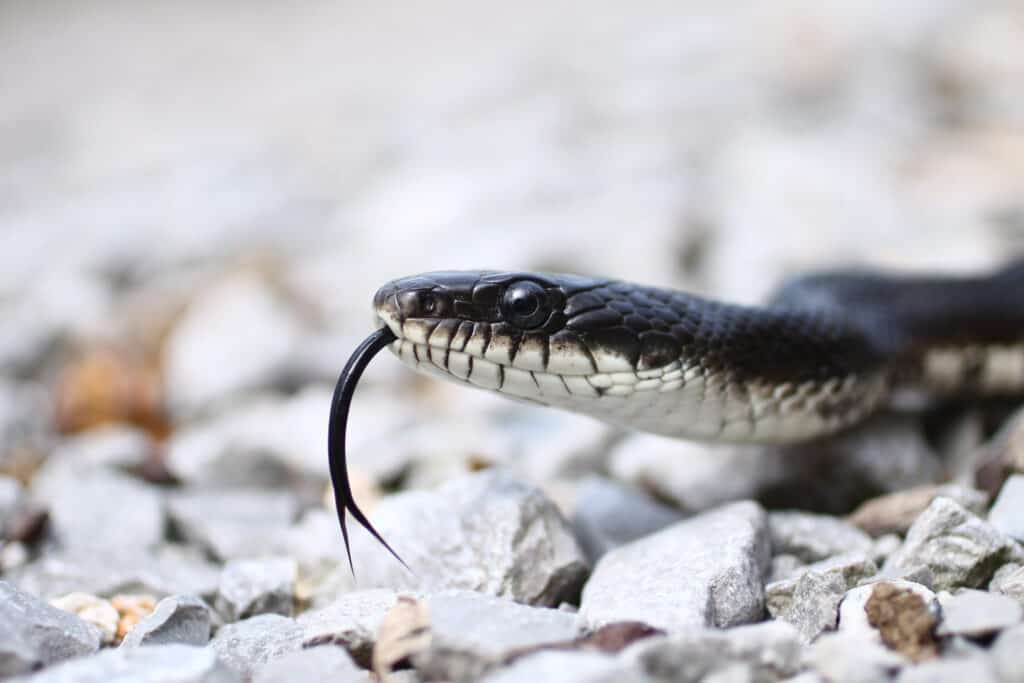
The black rat snake,
Pantherophis obsoletus, is one of
North America’s
most widespread black snakes.
©Seth LaGrange/Shutterstock.com
It turns out that the answer to the seemingly simple question “what is a black snake” varies pretty significantly depending on who you ask! Of course, to most people, it’s pretty much any snake that is mostly black in color. If you asked a herpetologist (as in, an animal biologist specializing in reptiles) the same question, though, they’d probably have a pretty different response.
This is because, scientifically and taxonomically, “black snakes” are actually a specific group of snakes within the Pseudechis genus. Notably, this genus falls under the Elapidae family of snakes, making this particular type of black snake quite closely related to other elapids like cobras and mambas.
In total, the Pseudechis genus houses 9 species of snakes. Together, they’re known as black snakes, and most of them have the word “black” somewhere in their common name.
However, there are also numerous other species of snakes spanning multiple genera and families that are mostly black in color with “black” in their common name, most notably:
- Black rat snake, Pantherophis obsoletus
- Black kingsnake, Lampropeltis nigra
- Southern black racer, Coluber constrictor priapus
- Northern black racer, Coluber constrictor constrictor
- Black swamp snake, Liodytes pygaea
- Black whipsnake, Dolichophis jugularis
- Black garter snake, Elapsoidea nigra
Pseudechis: The “Official” Black Snakes
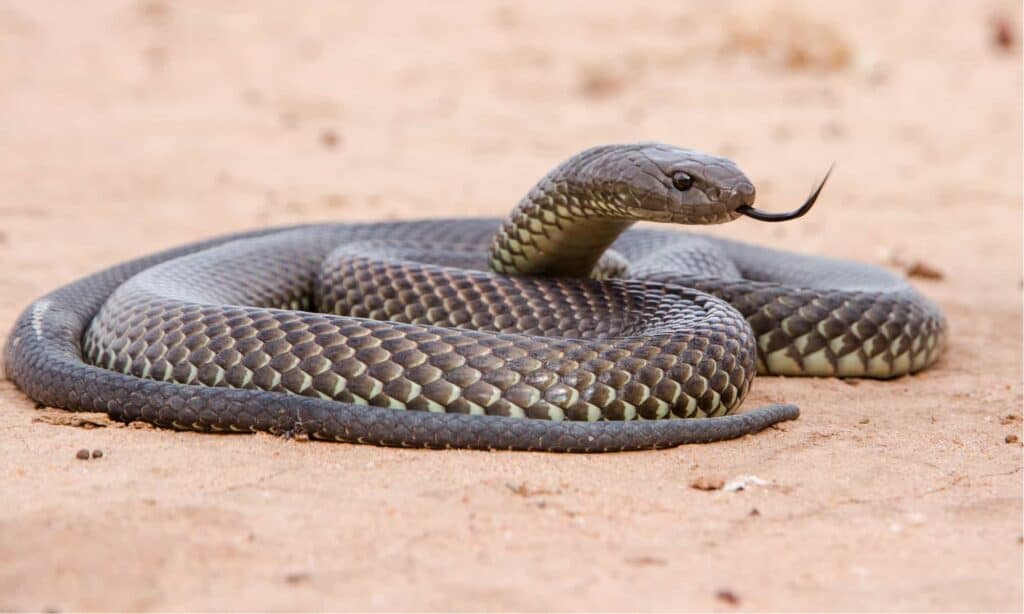
Despite technically being brown in color, the king brown snake is classified taxonomically as a black snake.
©Ken Griffiths/Shutterstock.com
As briefly touched on earlier, the term “black snake” is a bit harder to define than, say, “viper” or “python.” It can potentially refer to dozens of different species of snakes spanning multiple genera and even families.
However, taxonomically, there is a particular genus of elapid snakes that are collectively known as “black snakes.” This would be the Pseudechis genus, which contains nine total species, and most of them have the word “black” somewhere in their common name. All of them are native to parts of Australia and/or New Guinea. Like other snakes in the Elapidae family (like cobras and kraits), they have potent venom and prominent, constantly erect fangs at the front of their mouth.
In terms of appearance, these nine species are mostly similar yet still distinct. They range in color but are primarily gray, dark brown, or–you guessed it–a rich, glossy black. They’re collectively pretty slender yet substantial in size, with most of them ranging from around 5 to 10 feet long.
The largest species in this group (and perhaps the most well-known) is the king brown snake, Pseudechis australis, also known as the mulga snake. Confusingly, despite its common name describing the snake as brown in color, it is still more closely related to and therefore grouped with black snakes rather than true brown snakes. Its geographic range covers much of mainland Australia. The other eight species in this genus are the following:
- Pseudechis butleri, Butler’s black snake
- Pseudechis colletti, Collett’s black snake
- Pseudechis guttatus, Blue-bellied black snake
- Pseudechis pailsei, Eastern dwarf mulga snake
- Pseudechis papuanus, Papuan black snake
- Pseudechis porphyriacus, Australian black snake
- Pseudechis rossignolii, Papuan pygmy mulga snake
- Pseudechis weigeli, Pygmy king brown snake
Other Black Snakes: Black Rat Snake (Pantherophis obsoletus)
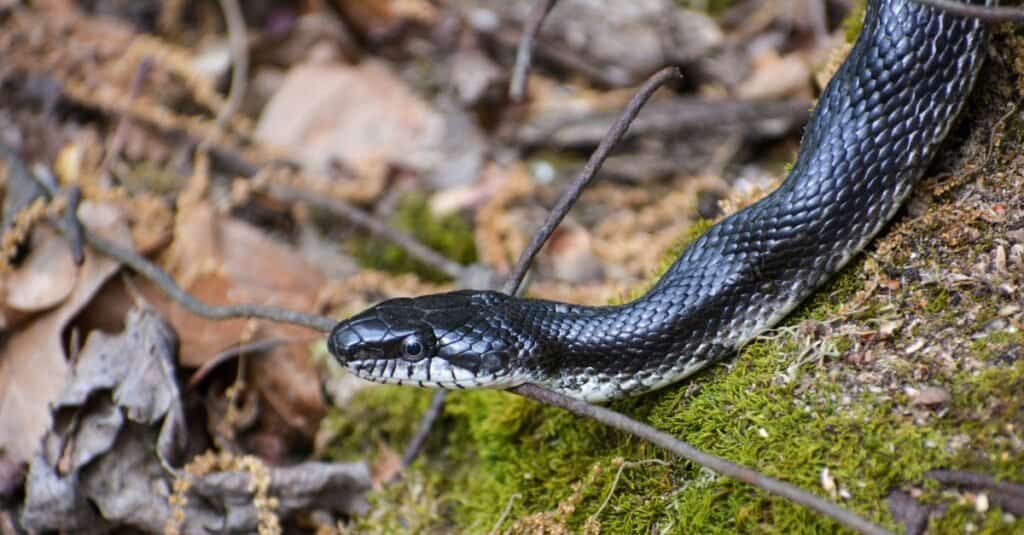
Although the black rat snake looks quite intimidating, it is non-venomous and generally non-aggressive towards humans.
©Realest Nature/Shutterstock.com
Aside from the species within the Pseudechis genus, there are many other species of snakes we’ve also come to know as black snakes.
One of the most well-known in North America is the black rat snake, Pantherophis obsoletus, which is native to much of the eastern United States. Black rat snakes are hardy and have adapted well to a wide range of habitats, but they prefer temperate, densely wooded forests. They often live near small bodies of water like ponds and streams and are agile both on land and in water.
As a constrictor snake, the black rat snake is non-venomous and considered harmless to humans. Its appearance can be quite frightening at first glance, though, with its shiny black scales, piercing black eyes, and impressive size maxing out at around 8 feet. Being part of the Pantherophis genus, this snake is quite closely related to the corn snake, Pantherophis guttatus!
Despite being known for eating a large number of rodents, the black rat snake isn’t too picky and will also commonly feed on other, smaller snakes, various types of birds and their eggs, lizards, frogs, and just about any small animals they can find.
Other Black Snakes: Black Kingsnake (Lampropeltis nigra)
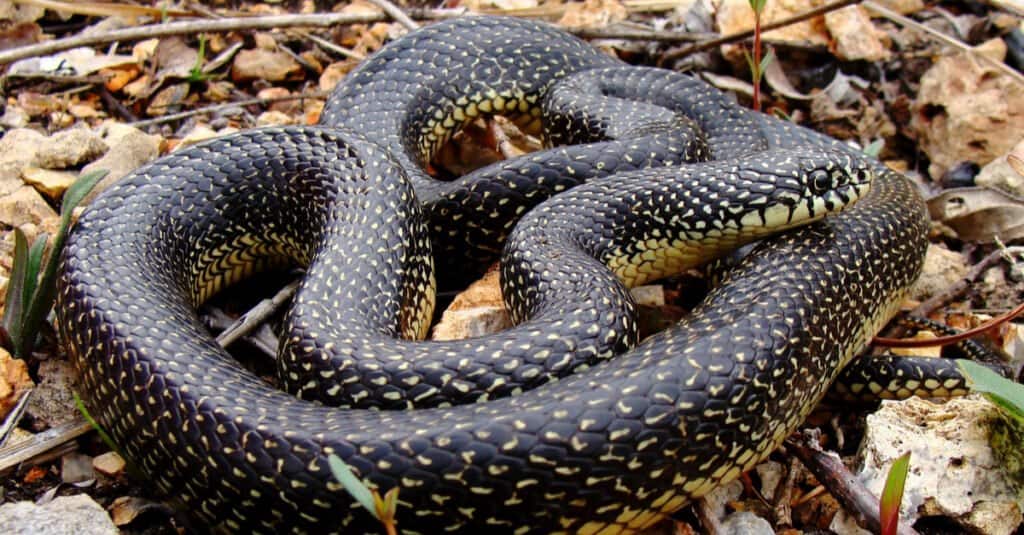
The eastern black kingsnake can be easily identified by its yellow markings.
©Matt Jeppson/Shutterstock.com
In addition to the aforementioned black snakes and black rat snakes, numerous other species of snakes have “black” somewhere in their common name. The black kingsnake is another species that is well-known and widespread throughout much of the United States, particularly in the Southeast.
Like many other kingsnakes within the Lampropeltis genus, the black kingsnake is an impressively large constrictor snake. On average, it reaches 5 to 6 feet in length when fully grown. Its scales are mostly a deep, glossy black, with tiny yellow spots or thin, irregular stripes throughout its body. These small pops of color make it a bit unique amongst snakes commonly known as black snakes.
Fortunately, the black kingsnake is non-venomous and generally not aggressive towards humans. In fact, it prefers habitats with lots of places for it to hide and avoid human contact whenever possible, like densely wooded forests, rock and wood piles, and thick brush near bodies of water.
Other Black Snakes: Black Racers (Coluber constrictor)
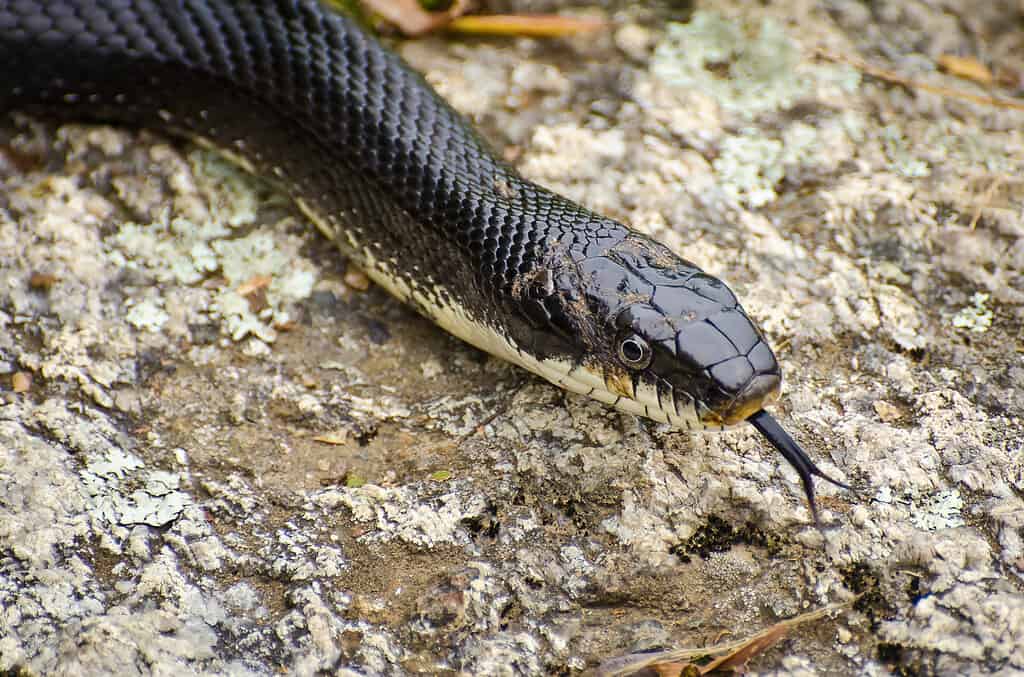
There are 11 subspecies of the eastern black racer snake, all of which are native to North America.
©iStock.com/RCKeller
Yet another type of snake often simply referred to as a black snake is the eastern black racer, a species similar in appearance to (and often confused with) the black rat snake. The two species also share similar geographic ranges with a lot of overlap.
This particular species consists of a whopping 11 total subspecies, with the northern and southern black racers often being among the most common and widespread throughout much of North America. They can even be found as far south as northern Mexico and as far north as southern Canada.
Since they are members of the Colubridae family, all 11 subspecies of eastern black racer snakes are non-venomous and rely on ambush and constriction to take down their prey. As their speedy-sounding name suggests, these snakes are remarkably agile. They are well-adapted to moving quickly on land and in water and are even skilled climbers, willing to feed on just about any animal small enough for them to efficiently take down.
Even More Black Snakes
We’ve covered the three main types of black snakes, but as we also touched on earlier, the term can be somewhat hard to define depending on who you ask. Incredibly, there are still many more species of snakes with the word “black” somewhere in their common name!
Take the black swamp snake, Liodytes pygaea, for instance, a solid black snake native to the southeastern United States. It is a member of the Natricinae subfamily of snakes, making it highly aquatic and an expert at taking down prey like fish and amphibians. It also is often confused with the black rat snake and black racers mentioned above, though it is much smaller than both species at only 10 to 15 inches long on average.
There’s also the black whipsnake, Dolichophis jugularis, another non-venomous colubrid snake native to eastern European and Middle Eastern countries like Iran, Iraq, Greece, Turkey, and Syria. Covered in glossy black scales, this slender serpent has three unique subspecies and is also non-venomous.
Finally, perhaps the most recognizable of these three outliers is the black garter snake, Elapsoidea nigra. However, it actually is not related to the common garter snake we know and love here in North America! Unlike the humble, shy garter snakes within the Thamnophis genus, the black garter snake is venomous and native to Kenya and Tanzania all the way to central Africa.
In short, depending on where you live, a “black snake” can be one of dozens of different species!
Summary of Types of Black Snakes
| Types of Black Snakes | Species | |
|---|---|---|
| 1 | “Official” Black Snakes, Pseudechis | Butler’s black snake, Collett’s black snake, Blue-bellied black snake, Eastern dwarf mulga snake, Papuan black snake, Australian black snake, Papuan pygmy mulga snake, Pygmy king brown snake |
| 2 | Black rat snake, Pantherophis obsoletus | |
| 3 | Black kingsnake, Lampropeltis nigra | |
| 4 | Southern black racer, Coluber constrictor priapus | |
| 5 | Northern black racer, Coluber constrictor constrictor | |
| 6 | Black swamp snake, Liodytes pygaea | |
| 7 | Black whipsnake, Dolichophis jugularis | |
| 8 | Black garter snake, Elapsoidea nigra |
The photo featured at the top of this post is © iStock.com/RCKeller
Discover the "Monster" Snake 5X Bigger than an Anaconda
Every day A-Z Animals sends out some of the most incredible facts in the world from our free newsletter. Want to discover the 10 most beautiful snakes in the world, a "snake island" where you're never more than 3 feet from danger, or a "monster" snake 5X larger than an anaconda? Then sign up right now and you'll start receiving our daily newsletter absolutely free.
Thank you for reading! Have some feedback for us? Contact the AZ Animals editorial team.






